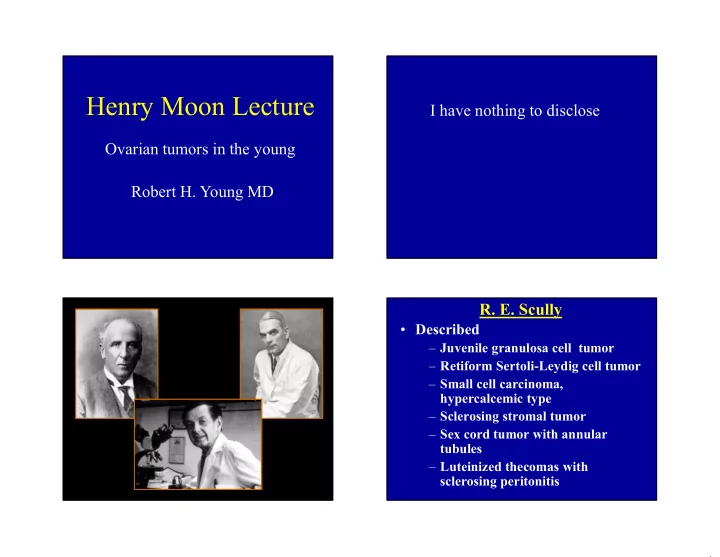

Henry Moon Lecture I have nothing to disclose Ovarian tumors in the young Robert H. Young MD R. E. Scully • Described – Juvenile granulosa cell tumor – Retiform Sertoli-Leydig cell tumor – Small cell carcinoma, hypercalcemic type – Sclerosing stromal tumor – Sex cord tumor with annular tubules – Luteinized thecomas with sclerosing peritonitis 1
OVARIAN TUMORS IN THE THE FIRST DECADE FIRST THREE DECADES • Primitive germ cell tumors uncommon Germ cell (1/3 primitive) 75% • Dermoids rare before 2 years Surface epithelial 10% • Surface epithelial tumors rare Sex cord-stromal 10% • All sex cord tumors seen Others including 5% • Follicle cysts common (esp. neonatal) lymphoma- leukemia • Small cell carcinoma rare tumor-like lesions THE THIRD DECADE THE SECOND DECADE • Primitive germ cell tumors still • Primitive germ cell tumors progressively more “common” frequent (peak 18-20 years) • Surface epithelial tumors and metastases • Surface epithelial tumors (esp. mucinous) seen each progressively more common with increased frequency • Sertoli-Leydig cell tumors peak • Retiform Sertoli-Leydig cell tumors peaks • Small cell carcinoma peaks • Follicle cysts common (perimenarchal) • Sclerosing stromal tumor peaks • Small cell carcinoma accelerates • Metastases rare but seen • Pregnancy-related issues most common 2
ISSUES RELATED TO OVARIAN MASSES DURING PREGNANCY 1. Non-specific changes 2. Ovarian pregnancy and trophoblastic lesions 3. Specific tumor-like lesions 4. Alterations in morphology of sex cord tumors 5. Function due to stromal luteinization PREGNANCY-RELATED TUMOR-LIKE LESIONS 1. Pregnancy luteoma 2. Hyperreactio luteinalis 3. Large solitary follicle cyst 4. Granulosa cell tumorlets 3
4
Ovarian Tumors with Functioning Stroma Tumors During pregnancy Trophoblast -Containing Tumors Idiopathic- Primary, Metastatic 5
Tumors in the young 1. Primitive germ cell tumors 2. But also dermoids! 3. Sex cord-stromal tumors a. Sertoli Leydig/Juvenile granulosa b. Some pure stromal tumors 4. Steroid cell tumors 5. Do not forget metastases, sadly 6. Selected specific beasts! a. Small cell carcinoma b. Desmoplastic small round cell tumor 6
Yolk Sac Tumor 7
IMMATURE TERATOMAS • Account for 20% of malignant germ cell tumors • Account for 15% of ovarian cancers in first two decades • Median age, 18 years • 25% have ipsilateral and 10% contralateral dermoid cyst • Rarely have elevated hCG and AFP levels Gross Features a Major Clue in Distinction Between Immature Teratoma and Dermoid Cyst 1 . Average size of immature teratoma 16 cm. 2 . Average size of dermoid cyst 8 cm. 3. Most immature teratomas solid and cystic, more the former and with worrisome appearance. 4. Dermoid cyst generally dominantly cystic and solid foci lack hemorrhage and necrosis. 5. A grossly typical dermoid is likely to be that after microscopic examination in vast likelihood. 8
Juvenile Granulosa cell tumor 0 - 67 (Av 13) yrs. 97% <30 yrs. Retiform Sertoli-Leydig cell tumor 2 - 39 (Av 15) yrs. Small Cell Carcinoma hypercalcemic type 1 - 44 (Av 23) yrs. 32 Cases (16 years or less) 26 JGCT 3 AGCT 3 Cystic, Nos 9
CARDINAL FEATURES OF JUVENILE GRANULOSA CELL TUMOR • Follicles that are typically variable in size and shape • Luteinized cells • Mitotically active • Pleomorphic cells in 10 – 15% of cases • Generally inconspicuous stroma 10
DIFFERENTIAL DIAGNOSIS – JUVENILE GRANULOSA CELL TUMOR • Adult granulosa cell tumor • Small cell carcinoma • Thecoma • Primitive germ cell tumors • Undifferentiated carcinoma • Transitional cell carcinoma • Clear cell carcinoma • Pregnancy luteoma • Large solitary follicle cyst 11
Luteinized Thecoma(tosis) Associated with Sclerosing Peritonitis (LTSP) • Age 10 mo to 85 y (median 27) • Abdominal distention, pain, ascites • Bilateral (25/27) • Sclerosing peritonitis (25/27) • 2-31 cm (mean 10 cm), round or lobulated • Soft, often markedly edematous, hemorrhagic 12
Sclerosing Stromal Tumor • Young women - 80% under 30 • Rarely hormone- producing • Unilateral, solid to cystic • Benign 13
14
F A A Type of Sertoli- R G N Leydig cell tumor E E D Well differentiated 15% 34 50% Intermediate 70% 25 45% Poorly differentiated 15% 25 53% Heterologous 20% 23 39% Retiform 15% 15 23% 15
16
17
Ovarian Tumors with Paraendocrine Small cell carcinoma of hypercalcemic type Hypercalcemia Small cell CA 59% CLINICAL PRESENTATION Clear cell CA 18% Age range 1 to 44 (mean 23) y Serous CA 6% Squamous cell CA in dermoid cyst 6% Abdominal pain and swelling Dysgerminoma 6% Elevated serum Ca ++ in 62% Mucinous CA 3% Rare familial cases Mixed clear cell/endometrioid CA 1% Steroid cell tumor 1% 99% unilateral 18
19
20
Recommend
More recommend